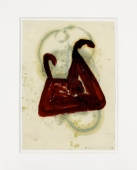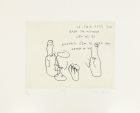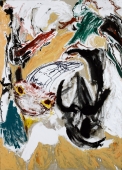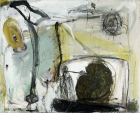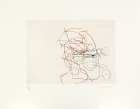
Artist | Abisag Tüllmann (1935 - 1996)
https://www.artist-info.com/artist/Abisag-Tuellmann
Biography
Biography
1935 geboren in Hagen/ Westfalen, aufgewachsen in Wuppertal
Sie absolvierte eine Schreinerlehre und arbeitete für einen Architekten, bevor sie ihre ersten Kenntnisse über Fotografie in Studios der Mode- und Werbefotografie erwarb.
1960er Freiberufliche Bildjournalistin für Zeitschriften wie „Magnum“, „Publik“, „Die Zeit“ und „Der Spiegel“
Sie zog in die Stadt Frankfurt am Main, die später zu einem Hauptmotiv ihres Lebenswerks wurde
1964 Theaterfotografin in Stuttgart, Bochum und Wien, an der Berliner Schaubühne, an der Brüsseler Oper und bei den Salzburger Festspielen
1970er/ 80er Fotografie-Dozentin an der Deutschen Film- und Fernsehakademie in Berlin und an Hochschulen in Kassel, Mainz, Frankfurt und Hamburg
1993 Reinhold-Kurth-Kunstpreis
1995 Sibylla-Merian-Förderpreis des hessischen Ministeriums für Kunst
1996 starb in Frankfurt am Main
About the work (english / deutsch)
About the work (english / deutsch)
Photo Journalism
This room of the MMK - Museum für Moderne Kunst, Frankfurt am Main, combines photos taken over 35 years. Photos which can be classified as photojournalism. Yet Abisag Tüllmann has also photographed the theater and the opera. And there are also numerous outstanding portraits. However, one could say with some justification that it is in her photo journalism that her attitude, her view of the world, her ability to participate in things, coupled with risk and courage, come mostfully to bear.
In 1963 Societäts-Verlag in Frankfurt brought out her Großstadt, a book of photos which has long since been out of print. It was an opulent book filled to burst with photos of Frankfurt. I would term it an incunabulum. Today, some thirty years later, the photos shown are not meant only as documents of a time of upheaval, they are meant to be pictures that speak for themselves. They are unusual pictures in which the element of knowledge goes hand in glove with the masterful composition to create an unforgettable unity. They are pictures that were made in Germany, France, Italy, North and South Africa, in Israel and in the Lebano.
As Abisag Tüllmann lives in Frankfurt it was possible to spend many months sifting through her archives with her. And together with her we chose the photos for the publication as well as those which will follow in the subsequent three exhibitions in the museum. I emphasize this cooperation because it was part of the work process and also part of my own learning process. Two examples are in order here. Abisag Tüllmann often made different prints from one and the same negative. There were photos where I was unsure whether we should include them, but immediately agreed on seeing different prints of them. I am talking here of pictures in which the range of different tones, the distinction between the finest degrees of difference in light first created the space in which the picture resonates.
The second example has to do with sequences. Some dramatic event is photographed in short intervals. A comparison of the different photos shows that of them only one particular picture can be considered unique. In what I term the unique picture the coincidences are so in tune with one another that the ensuing constellation seems to be the subject of careful composition. Seconds later the specific constellation collapses, even if only in the minutest way, and instead of the picture we are left with a document, a copy of the event. To put it differently: the picture clearly contains a document. However, the document only contains a copy of the event but no picture. The dramatics of the event only unfold in the picture: the picture is the dramatics of the event.
Television, with its reports of the daily news, has undermined our ability to see pictures. We see contents, but no longer see pictures. Contents, however moving they may be, can be readily exchanged. But that is not the case with pictures. Pictures remain before your mind’s eye. Which is why the best pictures are always those which you have seen somewhere before and at some time or other. Perhaps, because you remember a comparable photo, or perhaps, because in a specific situation and with a specific frame of mind, which you can no longer remember, you perceived something which remained engraved in your memory in the form of a picture of which you no longer know whether you really saw it or only saw a photo.
To this extent, with Abisag Tüllmann’s work the question of „new viewpoints“ in photography simply does not arise. All that counts is the view of the world: our daily perception, here lent concentrated form. Given that the world changes, the events in the pictures change, but the canon of pictures does not. It is precisely this which is so exceptional about photo journalism as a whole and about Abisag Tüllmann’s work in particular. The canon of pictures is constant, or to exaggerate somewhat, from Cartier-Bresson to Barbara Klemm and Abisag Tüllmann, the canon also functions as a means of distantiation enabling changes and fissures, new points of departure and modes of behavior to be kept for posterity all the more precisely, because it sidesteps all conformity to fads, be they ways of seeing things, presentations or technical innovations.
In the final instance, this canon of pictures also represents the view of the pedestrian, i.e. that which we have all but lost sight of with the constant talk of virtual realities and cyberspace. It is, as it were, the everyday gaze out of the subway window, on your way to work or your way back home in the evening. Everyone knows what this everyday gaze means: just like a smile or a helpful gesture can save the day, snottiness, pushiness or rude behaviour can be the cloud that darkens the horizon. I am intentionally talking about a gaze, because in both cases just mentioned the scenario focuses on pictures full of expression that talk to us and which we remember.
Abisag Tüllmann always focuses on people, even if they are sometimes absent from the pictures. Their traces are nevertheless still to be felt. Everyday people in all sorts of situations, marginalized and degraded, happy, at work, hopeful, protesting, melancholy, rebelling, exhausted, resigned to their fate, at play, filled with sorrow, anger, pleasure and curiosity.
German text by Jean-Christophe Ammann / Translation by Jeremy Gaines
(Printed version available in the Museum)
MMK - Museum für Moderne Kunst, Frankfurt am Main
Reportagefotografie
Dieser Raum vereint Fotos aus fünfunddreißig Jahren. Fotos, die der „Reportagefotografie“ zuzuordnen sind. Abisag Tüllmann fotografiert aber auch für Schauspiel und Oper, und es gibt außerdem viele hervorragende Porträts. Jedoch, so könnte man sagen, gelangen in der Reportagefotografie ihre Haltung, ihre Sicht von Welt, ihr Partizipationsvermögen, gepaart mit Risiko und Mut, am deutlichsten zum Ausdruck.
1963 erschien im Frankfurter Societäts-Verlag ihr heute längst vergriffener Bildband Großstadt. Ein pralles, dichtgefülltes Buch mit Fotos aus Frankfurt. Ich würde es als eine Inkunabel bezeichnen. Heute, rund dreißig Jahre später, sollen die Fotos nicht mehr nur Dokumente einer Aufbruchszeit sein, sie sollen auch, selbst sprechend, Bilder sein. Es sind ungewöhnliche Bilder, in denen das Moment der Erkenntnis mit der souveränen Komposition eine unvergeßliche Einheit eingeht. Es sind Bilder, die in Deutschland, Frankreich, Italien, in Nord- und Schwarzafrika, in Israel und dem Libanon entstanden sind.
Da Abisag Tüllmann in Frankfurt wohnt, war es möglich, gemeinsam mit ihr, über viele Monate hinweg, das Archiv zu durchforsten. Wir haben die Entscheidungen sowohl für die Fotos im Bildband als auch für jene in den drei aufeinanderfolgenden Ausstellungen im Museum gemeinsam getroffen. Ich hebe diese Gemeinsamkeit deshalb hervor, weil sie Teil des Arbeitsprozesses und Teil meines Lernprozesses gewesen ist. Zwei Beispiele mögen dies verdeutlichen. Abisag Tüllmann hat von ein und demselben Negativ häufig verschiedene Abzüge gemacht. Es gab Fotos, bei denen ich unsicher war, diese jedoch in einem anderen Abzug sofort befürwortete. Die Rede ist von Bildern, in denen die Auffächerung der Tonwerte, die Ausdifferenzierung der feinsten Lichtstufe eigentlich erst den Resonanzraum des Bildes schafft.
Das zweite Beispiel betrifft Sequenzen. Ein dramatisches Geschehen wird kurz nacheinander fotografiert. Der Vergleich der verschiedenen Fotos zeigt, daß nur dieses eine und kein anderes das einmalige Bild sein kann. In dem als einmalig bezeichneten Bild ist die Konstellation von Zufällen derart aufeinander abgestimmt, daß es wie durchkomponiert erscheint. Sekunden später bricht diese Konstellation, wenn auch nur um einen Bruchteil, auseinander, und statt des Bildes haben wir ein Dokument, ein Abbild vor Augen. Mit anderen Worten: Das Bild enthält sehr wohl das Dokument. Das Dokument jedoch enthält nur das Abbild (des Ereignisses), nicht aber das Bild. Die Dramatik eines Geschehens spielt sich einzig und allein im Bild ab: Das Bild ist die Dramatik des Geschehens.
Das Fernsehen mit seinen Reportagen über die Tagesaktualitäten hat uns das Sehen von Bildern verlernt. Wir sehen zwar Inhalte, aber wir sehen keine Bilder mehr. Inhalte, so bewegend sie auch sein mögen, sind austauschbar. Nicht jedoch Bilder. Bilder bleiben haften. Deshalb sind die besten Bilder immer auch diejenigen, die man irgendwo und irgendwann einmal gesehen hat. Vielleicht, weil man sich an ein vergleichbares Foto erinnert, vielleicht aber auch, weil man selbst in einer bestimmten Situation und in einer bestimmten Gemütslage etwas wahrgenommen hat, das sich als Bild eingeprägt hat, von dem man dann nicht mehr weiß, ob man es in der Wirklichkeit oder auf einem Foto gesehen hat.
Insofern stellt sich im Falle von Abisag Tüllmann in keinster Weise die Frage nach „neuen Gesichtspunkten“ in der Fotografie. Allein die Sicht von Welt ist ausschlaggebend: die tägliche, beispielhaft verdichtete Wahrnehmung. Da sich die Welt verändert, verändern sich auch die Geschehnisse in den Bildern, nicht aber der Bildkanon. Das gerade ist das Außergewöhnliche in der Reportagefotografie allgemein und im Schaffen von Abisag Tüllmann im besonderen. Der konstante Bildkanon - ich sage bewußt pointiert: von Cartier-Bresson zu Barbara Klemm und Abisag Tüllmann - ist gleichzeitig auch ein Distanzierungsmittel, das die Veränderungen und Umbrüche, Aufbrüche und Verhaltensweisen um so präziser festzuhalten vermag, weil es jeder modischen Anpassung, seien es Sichtweisen, Präsentationen oder technische Errungenschaften, aus dem Wege geht.
Letztlich bezeichnet dieser Bildkanon auch die Sicht des Fußgängers, also jene, die uns allen eigen ist, und die man ob dem Gerede von virtuellen Realitäten bis zu Cyberspace schier aus dem Blickfeld verloren hat. Es ist gewissermaßen jener tägliche Blick in der U-Bahn, auf dem Weg zur Arbeit und abends nach Hause. Jeder weiß, was dieser tägliche Blick bedeutet: So wie ein Lächeln oder eine hilfreiche Geste den Tag verschönern kann, so kann umgekehrt eine Schnodderigkeit, Drängeln, ungehobeltes Verhalten wie eine Wolke das Gemüt verdunkeln. Ich rede sehr wohl vom Blick, denn im einen wie im anderen Fall sind es ausdrucksbetonte Bilder, die zu uns sprechen und die sich uns einprägen.
Der Mensch ist immer im Blickpunkt von Abisag Tüllmann, auch wenn er im Bild abwesend ist. Seine Spuren bezeugen es. Es ist der alltägliche Mensch, wo auch immer, ausgesetzt und erniedrigt, fröhlich, arbeitend, hoffend, protestierend, melancholisch, rebellierend, erschöpft, schicksalsergeben, spielend, von Trauer, Wut, Wohlgefälligkeit und Neugier geprägt.
Text von Jean-Christophe Ammann
(Informationsblatt beim Museum erhältlich)
MMK - Museum für Moderne Kunst, Frankfurt am Main
Bibliography
Bibliography
Ammann, Jean-Christophe/Hansen, Olaf: Abisag Tüllmann. Photographien. Verlag Cantz, Ostfilder-Ruit, 1995.
ISBN: 3-88270-473-X
 offers / Requests offers / Requests  |
About this service |
|---|
 Exhibition Announcements Exhibition Announcements  |
About this service |
|---|
 Visualization |
Learn more about this service | ||
|---|---|---|---|

Interested in discovering more of this artist's networks?
3 easy steps: Register, buy a package for a visualization, select the artist.
See examples how visualization looks like for an artist, a curator, or an exhibition place: Gallery, museum, non-profit place, or collector.

Exhibition History

|
SUMMARY based on artist-info records. More details and Visualizing Art Networks on demand. Venue types: Gallery / Museum / Non-Profit / Collector |
||||||||||||
| Exhibitions in artist-info | 15 (S 3/ G 12) |
Did show together with - Top 5 of 149 artists (no. of shows) - all shows - Top 100
|
||||||||||
| Exhibitions by type | 15: 1 / 12 / 2 / 0 | |||||||||||
| Venues by type | 8: 1 / 5 / 2 / 0 | |||||||||||
| Curators | 6 | |||||||||||
| artist-info records | Aug 1994 - Sep 2024 | |||||||||||
|
Countries - Top 2 of 2 Germany (14) United States (1) |
Cities 4 - Top of 4 Frankfurt am Main (11) Berlin (2) New York (1) Hofheim/Ts. (1) |
Venues (no. of shows )
Top 5 of 8
|
||||||||||
Curators (no. of shows)
Top 5 of 6
|
| Historisches Museum Frankfurt | G | May 2024 - Sep 2024 | Frankfurt am Main | (4) | +0 | |
| Böttger, Katharina (Curator) | +0 | |||||
| Linnemann, Dorothee (Curator) | +0 | |||||
| May, Ulrike (Curator) | +0 | |||||
| Ramsch, Christina (Curator) | +0 | |||||
| Strathaus, Bettina Schulte (Curator) | +0 | |||||
| Tower - MMK | G | Mar 2018 - Jul 2018 | Frankfurt am Main | (10) | +0 | |
| Stadtmuseum Hofheim | G | Jun 2012 - Sep 2012 | Hofheim / Ts. | (37) | +0 | |
| Museum für Fotografie | S | Jun 2011 - Sep 2011 | Berlin | (21) | +0 | |
| Kunstbibliothek - Staatliche Museen zu Berlin | S | Jun 2011 - Sep 2011 | Berlin (Tiergarten) | (37) | +0 | |
| Museum - MMK | G | Sep 2010 - Apr 2011 | Frankfurt am Main | (106) | +0 | |
| Keep reading |
















